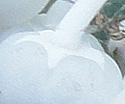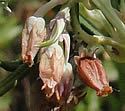Andromeda polifolia (Bog Rosemary)
| Also known as: | |
|---|---|
| Genus: | Andromeda |
| Family: | Ericaceae (Heath) |
| Life cycle: | perennial woody |
| Origin: | native |
| Habitat: | part shade, sun; cedar/spruce bogs, sphagnum wetlands, acidic shores |
| Bloom season: | May - June |
| Plant height: | 6 to 20 inches |
| Wetland Indicator Status: | GP: OBL MW: OBL NCNE: OBL |
| MN county distribution (click map to enlarge): |  |
| National distribution (click map to enlarge): |  |
Pick an image for a larger view. See the glossary for icon descriptions.
Detailed Information
Flower: 


![[photo of flowers]](/udata/r9ndp23q/pd/andomeda-glaucophylla-10-3-t.jpg) As many in the Ericaceae family, the ¼-inch flowers have 5 petals fused into a hanging bell, this one more globose than most. Flower color ranges from pure white to pink, with tiny petal lips curled back away from the small mouth. 3 to 9 in a cluster at the ends of branching stems, they are attached by stout creamy white stalk about 3/8 inch long. Sepals are also white, triangular, 1/8 inch long. Ten stamens are inside the globe along with a single pistil that persists on the seed capsule.
As many in the Ericaceae family, the ¼-inch flowers have 5 petals fused into a hanging bell, this one more globose than most. Flower color ranges from pure white to pink, with tiny petal lips curled back away from the small mouth. 3 to 9 in a cluster at the ends of branching stems, they are attached by stout creamy white stalk about 3/8 inch long. Sepals are also white, triangular, 1/8 inch long. Ten stamens are inside the globe along with a single pistil that persists on the seed capsule.
Leaves and stem: 

![[photo of leaves]](/udata/r9ndp23q/pd/andromeda-glaucophylla-4980-2-t.jpg) Leaves are typically all held erect from the upper side of the branch stem, evergreen into 2nd year, simple, alternate, narrow to linear, base and tip tapered, the tip to a sharp point. Leaves are 1 to 2 inches long and 1/10 to 1/3 inch wide, the edges tightly rolled under. The upper surface is dark bluish green, low lustre, the lower surface more whitish, densely covered in fine hairs. Stems are upright or spreading and ascendant, new stems are brown and smooth turning gray by second year and aging back to smooth brown or purplish. Stems will root at nodes into the cushy moss layer.
Leaves are typically all held erect from the upper side of the branch stem, evergreen into 2nd year, simple, alternate, narrow to linear, base and tip tapered, the tip to a sharp point. Leaves are 1 to 2 inches long and 1/10 to 1/3 inch wide, the edges tightly rolled under. The upper surface is dark bluish green, low lustre, the lower surface more whitish, densely covered in fine hairs. Stems are upright or spreading and ascendant, new stems are brown and smooth turning gray by second year and aging back to smooth brown or purplish. Stems will root at nodes into the cushy moss layer.
Fruit: 
![[photo of fruit]](/udata/r9ndp23q/pd/andomeda-glaucophylla-10-1-t.jpg) Fruit is a small round 5-sectioned capsule containing many seeds; the remains of the pistil persists at the top.
Fruit is a small round 5-sectioned capsule containing many seeds; the remains of the pistil persists at the top.
Notes:
Of its three contemporary, and of similar habit, evergreen wetland shrubs—Chamaedaphne calyculata, Kalmia polifolia and Rhododendron groenlandicum—Bog Rosemary is the most difficult to come across, especially in bloom. I always find it sparse and after the fact. Unlike the others species, this has a frequent cultivar in the nursery trade. Before you run out and buy one I can't say I've ever seen it performing well in a home landscape for all the thousands of very cute and appealing 1-gallon pots I've seen in the retail centers. If you'd like the challenge be prepared to do some serious site modification, otherwise a fool and their money will soon be parted. There is a reason it evolved and persists only in sphagnum bogs. While the leaves and common name resemble those of the popular cooking herb rosemary, the two are not related. Bog Rosemary also commonly goes by Latin name Andromeda glaucophylla or Andromeda polifolia var. glaucophylla, but the accepted name in Minnesota is Andromeda polifolia. There are 2 varieties in North America, with var. latifolia found in Minnesota.
Native Plant Nurseries, Restoration and Landscaping Services ↓
More photos
Photos courtesy Peter M. Dziuk, taken at several locations in central Aitkin county.
Comments
Have you seen this plant in Minnesota, or have any other comments about it?
on: 2016-03-13 18:34:32
Found in sphagnum bogs near the Embarrass river under larch and black spruce over-story accompanying plants like ledum, wintergreen, and moccasin flower.
on: 2023-07-19 11:28:56
Saw this blooming in Tigercat Flowage east of Hayward 7/19/2023.







 Bog Rosemary plant
Bog Rosemary plant spent flowers
spent flowers a colony of sprouting plants
a colony of sprouting plants cultivated nursery stock
cultivated nursery stock